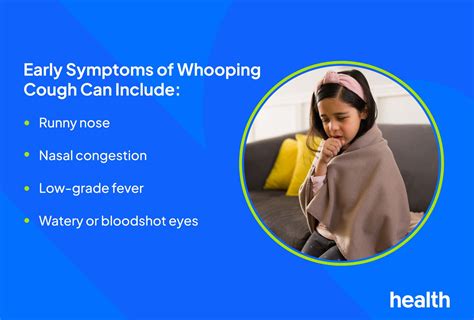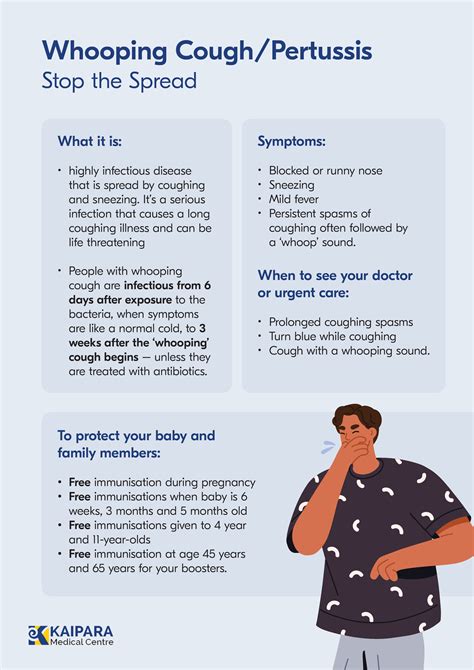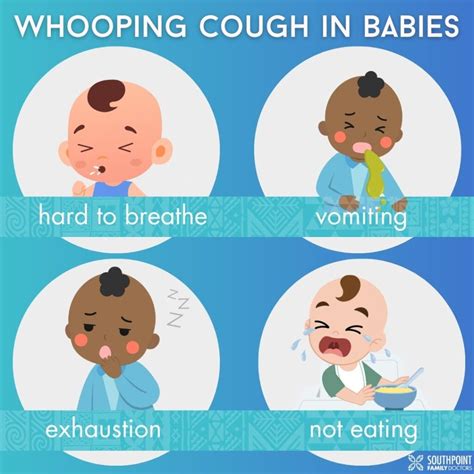Intro
Discover what is whooping cough, its symptoms, and treatment. Learn about pertussis causes, vaccination, and prevention methods to protect against this contagious respiratory disease.
Whooping cough, also known as pertussis, is a highly contagious respiratory illness caused by the bacterium Bordetella pertussis. It is characterized by severe coughing fits, often accompanied by a distinctive "whoop" sound, which can be debilitating and even life-threatening, especially for young children and infants. The disease is spread through respiratory droplets that are released when an infected person coughs or sneezes, and it can also be spread by touching surfaces that have been contaminated with the bacteria.
Pertussis is a significant public health concern, as it can cause serious complications, such as pneumonia, seizures, and brain damage, particularly in vulnerable populations like infants, young children, and people with weakened immune systems. According to the World Health Organization (WHO), pertussis is one of the leading causes of vaccine-preventable deaths worldwide, with an estimated 24.1 million cases and 160,700 deaths reported in 2019.
The importance of understanding whooping cough cannot be overstated, as it is a preventable disease that can be controlled through vaccination and proper hygiene practices. By learning more about the causes, symptoms, diagnosis, treatment, and prevention of pertussis, individuals can take steps to protect themselves and their loved ones from this debilitating illness.
Causes and Risk Factors of Whooping Cough

Whooping cough is caused by the bacterium Bordetella pertussis, which is transmitted through respiratory droplets that are released when an infected person coughs or sneezes. The bacteria can also be spread by touching surfaces that have been contaminated with the bacteria. The risk of contracting pertussis is higher in certain populations, including:
- Infants and young children who are not fully vaccinated
- People with weakened immune systems, such as those with chronic illnesses or taking immunosuppressive medications
- Pregnant women, who can pass the infection to their unborn baby
- Healthcare workers and caregivers who are exposed to infected individuals
- People who are not up-to-date on their pertussis vaccinations
Symptoms of Whooping Cough
The symptoms of whooping cough typically develop within 7-10 days after exposure to the bacteria and can be divided into three stages:- Catarrhal stage: This stage is characterized by mild respiratory symptoms, such as coughing, sneezing, and runny nose.
- Paroxysmal stage: This stage is marked by severe coughing fits, often accompanied by a distinctive "whoop" sound, which can be debilitating and even life-threatening.
- Convalescent stage: This stage is characterized by a gradual recovery from the illness, during which the coughing fits become less frequent and less severe.
Diagnosis and Treatment of Whooping Cough

The diagnosis of whooping cough is typically made based on the presence of characteristic symptoms, such as severe coughing fits and a distinctive "whoop" sound. Laboratory tests, such as PCR (polymerase chain reaction) or serology, may be used to confirm the diagnosis.
The treatment of whooping cough typically involves a combination of antibiotics and supportive care, such as:
- Antibiotics: Antibiotics, such as azithromycin or clarithromycin, may be prescribed to help clear the infection and reduce the risk of transmission to others.
- Supportive care: Supportive care, such as rest, hydration, and cough suppression, may be provided to help manage symptoms and prevent complications.
Prevention of Whooping Cough
The prevention of whooping cough is critical to controlling the spread of the disease. The following measures can be taken to prevent pertussis:- Vaccination: Vaccination is the most effective way to prevent whooping cough. The pertussis vaccine is typically administered in combination with other vaccines, such as diphtheria and tetanus toxoids.
- Proper hygiene: Proper hygiene practices, such as washing hands frequently and avoiding close contact with infected individuals, can help reduce the risk of transmission.
- Respiratory etiquette: Respiratory etiquette, such as covering the mouth and nose when coughing or sneezing, can help reduce the risk of transmission.
Complications of Whooping Cough

Whooping cough can cause serious complications, particularly in vulnerable populations like infants, young children, and people with weakened immune systems. Some of the possible complications of pertussis include:
- Pneumonia: Pneumonia is a serious complication of whooping cough that can be life-threatening, especially in infants and young children.
- Seizures: Seizures can occur in some cases of whooping cough, particularly in infants and young children.
- Brain damage: Brain damage can occur in some cases of whooping cough, particularly in infants and young children.
- Death: Death can occur in some cases of whooping cough, particularly in infants and young children.
Outbreaks of Whooping Cough
Outbreaks of whooping cough can occur in any setting, including schools, healthcare facilities, and communities. The risk of an outbreak is higher in areas with low vaccination rates or where the pertussis vaccine is not widely available.Global Efforts to Control Whooping Cough

Global efforts to control whooping cough are underway, including:
- Vaccination campaigns: Vaccination campaigns are being implemented in many countries to increase vaccination rates and reduce the risk of transmission.
- Surveillance: Surveillance systems are being established to monitor the spread of the disease and identify areas where outbreaks are occurring.
- Research: Research is being conducted to develop new and more effective vaccines, as well as to improve our understanding of the disease and its transmission.
Role of Healthcare Workers in Controlling Whooping Cough
Healthcare workers play a critical role in controlling whooping cough, including:- Diagnosis and treatment: Healthcare workers are responsible for diagnosing and treating cases of whooping cough.
- Vaccination: Healthcare workers are responsible for administering pertussis vaccines and promoting vaccination among their patients.
- Education: Healthcare workers are responsible for educating their patients and the public about the risks and prevention of whooping cough.
What is the most effective way to prevent whooping cough?
+Vaccination is the most effective way to prevent whooping cough. The pertussis vaccine is typically administered in combination with other vaccines, such as diphtheria and tetanus toxoids.
What are the symptoms of whooping cough?
+The symptoms of whooping cough typically develop within 7-10 days after exposure to the bacteria and can be divided into three stages: catarrhal, paroxysmal, and convalescent.
Can whooping cough be treated with antibiotics?
+Yes, antibiotics, such as azithromycin or clarithromycin, may be prescribed to help clear the infection and reduce the risk of transmission to others.
We hope this article has provided you with a comprehensive understanding of whooping cough, its causes, symptoms, diagnosis, treatment, and prevention. If you have any further questions or concerns, please do not hesitate to comment below or share this article with others. By working together, we can help control the spread of this debilitating illness and protect vulnerable populations from its devastating effects.
